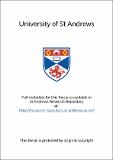Files in this item
A μSR study of unconventional superconductors
Item metadata
| dc.contributor.advisor | Cywinski, Bob | en |
| dc.contributor.author | Hillier, Adrian | en |
| dc.coverage.spatial | 204p | en |
| dc.date.accessioned | 2021-04-08T08:45:32Z | |
| dc.date.available | 2021-04-08T08:45:32Z | |
| dc.date.issued | 1999 | |
| dc.identifier.uri | https://hdl.handle.net/10023/21802 | |
| dc.description.abstract | The problem of finding an appropriate classification scheme for the remarkably diverse range of known superconducting materials is a long standing one. Nevertheless the literature abounds with claims of discoveries of "new classes" of superconductors, although the nature of the "class" is rarely defined explicitly. In cases where the structural, electronic or magnetic properties of the new superconductor are particularly unusual it is tempting to accept such claims: heavy fermions, high Tc cuprates, organic superconductors and buckminsterfullerenes are all examples of superconducting materials which superficially have little in common either with each other or with the more conventional superconducting elements and compounds and might therefore be considered as genuinely belonging to different classes. However the underlying uniformity of the superconducting ground state and its general conformity with the predictions of BCS theory continues to unite an extraordinarily disparate group of superconducting materials. Consequently over the last few decades there have been numerous attempts to provide an empirical framework, based upon the fundamental parameters of the superconducting state, within which superconducting materials can be compared and contrasted, thus enabling classes of superconductor to be unambiguously identified. For example, until the early 1980s a correlation between the superconducting transition temperature, Tc, and the Sommerfeld constant, i.e. the coefficient of the linear electronic specific heat 𝛶, was frequently invoked. A plot of logTc versus log 𝛶 was found to yield an approximately universal curve (see figure 1.1) ¹. However, first the heavy fermion compounds, with enormous 𝛶 s yet low transition temperatures and then, later, the cuprates with modest 𝛶 s but remarkably high Tcs proved to be marked exceptions to this universality, apparently confirming their status as members of new, exotic classes of superconductors. More recently a rather surprising universal scaling relationship has emerged from systematic transverse field muon spin rotation (μSR) measurements of flux penetration in superconducting systems. Uemura and co-workers ² were the first to recognise the new scaling relationship, observing that for several different members of the family of high temperature cuprate superconductors an initial increase in carrier doping leads to precisely the same linear increase of Tc with the muon spin depolarisation rate, σ. Deviations from linearity, first appearing as a saturation and then a suppression of Tc, only appears at high levels of doping. Remarkably, several Chevrel phase superconductors were also found to follow the same linear relationship, while bismuthates, fullerenes, organic superconductors and heavy fermion compounds exhibit a similar scaling behaviour3,4. The correlation between Tc and σ observed in μSR studies has suggested a new empirical framework for classifying superconducting materials. In this thesis I shall briefly review the role played by μSR in establishing this new classification scheme, and discuss the underlying physical phenomena responsible for the observed correlations. I shall present some μSR measurements on a range of superconducting families and attempt to interpret the results of these measurements within the proposed classification scheme. | en |
| dc.language.iso | en | en |
| dc.publisher | University of St Andrews | en |
| dc.subject.lcc | QC612.S8H5 | |
| dc.subject.lcsh | Superconductors | en |
| dc.title | A μSR study of unconventional superconductors | en |
| dc.type | Thesis | en |
| dc.type.qualificationlevel | Doctoral | en |
| dc.type.qualificationname | PhD Doctor of Philosopy | en |
| dc.publisher.institution | The University of St Andrews | en |
| dc.contributor.institution | Physics & Astronomy Theses | en |
This item appears in the following Collection(s)
Items in the St Andrews Research Repository are protected by copyright, with all rights reserved, unless otherwise indicated.

